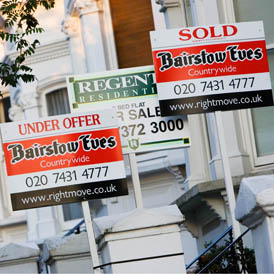Scope widens for first-time house buyers
The number of UK towns and cities that are affordable to first-time buyers is at its highest in a decade due to the sluggish housing market, a new study claims.

Those taking their first step on the property ladder will find homes within their means in 54% of local authority districts, the highest proportion since 2002 when 64 per cent of districts were within buyers’ reach, the Halifax building society found.
This is up from 40 per cent a year ago and almost eight times the proportion of affordable districts at the peak of the housing market in 2007, when just 7% were in this bracket.
A widening North-South divide was highlighted, with London being the only region where there were no affordable areas found for would-be buyers on average earnings. By contrast, 100 per cent of districts in the North East were within buyers’ grasp.
Just 9 per cent of the affordable districts are in the South East, the South West or the East of England, compared with 15 per cent 10 years ago.
This means 91 per cent of the affordable districts are in the North East, North West, Yorkshire and the Humber, East Midlands, West Midlands, Scotland, Wales or Northern Ireland, up from 85 per cent in 2002.
London strong
House prices have been holding up in London, which has had strong interest from overseas buyers, as well as some commuter belt areas, compared with the patchier market in the rest of the UK.
House prices in Northern Ireland, for example, which saw a steep increase before the financial crisis, have fallen by around 10 per cent over the last year.
Brent in London was named the least affordable district in the UK, where homes cost 8.8 times average earnings, while South Ayrshire in Scotland is the most affordable, with average property prices at just two and a half times the local annual wage.
Districts were deemed “affordable” if the average house price for a first-time buyer there was lower than what someone on typical earnings living there could pay.
Local average earnings were multiplied by four and if the average price paid by a first-time buyer was lower than this sum, it was classed as affordable.
The study warned that aspiring home owners still face “significant hurdles” amid the uncertain economy.
Borrowing ‘tougher’
Lenders have been tightening their loan criteria and the Bank of England has said borrowing will get tougher this year, especially for those with lower deposits to put down.
Rents have soared as those unable to get on the property ladder have remained trapped in the rental sector. Halifax found that the average first-time deposit of £27,857 this year was 1% lower than a year ago, but a 59 per cent increase compared with 2002.
Londoners need to find the biggest deposits, typically putting down nearly £60,000, while those in Northern Ireland put down the lowest deposits at just over £16,000.
Halifax housing economist Martin Ellis said the findings suggested there could be an increase in first-time buyer numbers this year, although this would still be from a low level.
He said: “This partly reflects the substantial improvement in home affordability for first-time buyers since 2007, following the fall in house prices over the period.
“However, the continued uncertainty over the outlook for the UK economy and the difficulties faced by many in raising the necessary deposit remain significant hurdles for those wishing to buy their first home.”